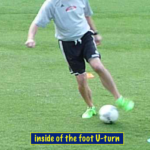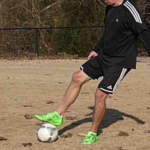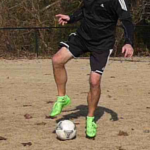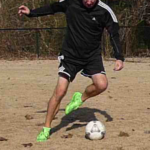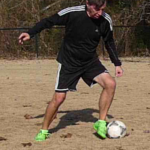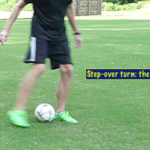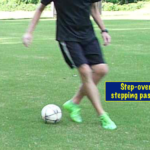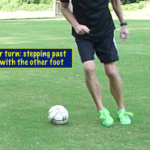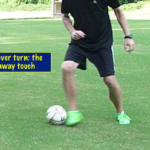Dribbling: quick links
- Basic dribbling skills
- Dribbling turns
- V-pull moves
- Stop and go moves
- Moves to get behind a defender
- Dribbling courses
- 1v1 dribbling games
Dribbling turns:
If you’ve developed good dribbling control, you’re ready to learn some dribbling turns. Dribbling turns allow you to get away from a defender and attack open space. They are useful anywhere on the field.
The best soccer players can change directions and turn the ball. Otherwise one defender could stand in front of them and shut them down.
Dribbling turns are useful in these situations:
- A defender is blocking your path.
- You’re dribbling toward a boundary line.
- You’re dribbling away from the opponent’s goal.
A sweet in-game turn by a U8 Junior Academy player:
Keys to dribbling turns:
- Use the foot that’s farthest away from the defender. (This allows you to keep your body between the defender and the ball.)
- Turn away from the defender, not into her. (Use your body to “shield” the ball.)
- Accelerate into open space (“explode”) to lose the defender.
- Bend your knees as you make your turn.
- Take a firm get-way touch. (Push the ball a few steps out from your feet, away from the defender.)
- Move with the ball into the open space.
Learn step by step:
- As you learn these moves, start in open space. Just practice the move and try to master the footwork.
- Once you understand the footwork, add an imaginary defender, This could be a tree, or your soccer bag, or a water bottle. (Use your imagination.) Dribble toward the imaginary defender, do your move, and then explode away from the imaginary defender. This step allows you to figure out how much space you need to do the move without running into the defender.
- When you’re ready for the next step, add a real defender and play a 1v1 game, such as “electric fence” or “snow cones“. You can play against a sister, brother, parent or friend. If you have a dog, let her be the defender!
Dribbling turns: quick links
- Cuts
- Pullbacks
- U-turns (also called hook turns)
- Twist-off turns (also called shielding turns)
- Stop turn
- Step-over turns
- Stop turn / step-over turn combination (advanced)
- Cruyff turn
- V-pulls
- Tornado turn (advanced)
Cuts:
In soccer, the word “cut” refers to a change of direction while dribbling. Try them out! While dribbling the ball, use the inside and outside of both feet to practice changing direction.
- If you’re dribbling to your left, you can use the inside of your left foot, or the outside of your right foot, to “cut” the ball back to the right.
- If you’re dribbling to your right, you can use the inside of your right foot, or the outside of your left foot, to “cut” the ball back to the left.
- Depending on the angle of your foot, the cut could be a small change of direction, or a big change of direction like a 180-degree U-turn.
Cuts using the inside of the feet:
Cuts using the outside of the feet:
Cuts using both inside and outside of the feet:
Pullbacks:
The pullback move works best at slow and medium speeds. If you’re going fast, a stop turn or a sole of the foot U-turn may be a better option.
A pullback by itself is a fundamental skill. But add another touch to a pullback, and you create a whole bunch of possibilities, including a pull-push stop-and-go move, or a V-pull move.
Pullback player and coach demos:
Pullback player demo:
Pullback coach demo:
Pullback details:
- Dribble the ball, and then stop the ball with the sole of your dribbling foot. (Sole of the foot: use the area between the ball of your foot and the bottom of your toes — it gives you the best feel for the ball.) Take a soft touch to stop the ball; don’t stomp on it.
- Pull the ball backwards using the sole of your foot, while turning your hips and shoulders. If you’re doing a right foot pullback, turn to the right. If you’re doing a left foot pullback, turn to the left. This allows you to see the ball as you turn.
- After you do the pullback, take a firm getaway touch and accelerate into open space (explode!) to finish the move and lose the defender.
The “Texas Draw” game:
Want to learn pullbacks by playing a game? Find a friend or family member and play the game we call Texas Draw. It’s lots of fun, plus it helps you get quicker feet and do better pullbacks. You only need a small space, so you can play Texas Draw at home.
Moves that include pullbacks:
When you get good at basic pullbacks, you are ready to learn some related moves that start with a pullback:
- The pull-push stop and go move.
- Any of the family of V-pull moves. Link: all about V-pulls
U-turns (also called “hook” turns):
U-turns are quick changes of direction, where you take a path that looks like the letter “U” or the shape of a hook. You can do U-turns with the inside, outside or sole of your foot.
Inside of the foot U-turn:
 Dribble or run with the ball with one foot.
Dribble or run with the ball with one foot.- Reach past the ball with your other foot. (Reach past the ball instead of running past the ball. This helps you trick the defender.)
- Cut the ball back with the inside of that foot.
- Accelerate into open space (explode!) to finish the move and lose the defender.
You can also do this move using a single foot, but it’s more difficult because your non-kicking foot could accidentally block your getaway touch.
Outside of the foot U-turn:
- Dribble or run with the ball with one foot.
- Reach past the ball with your dribbling foot. (Reach past the ball instead of running past the ball. This helps you trick the defender.)
- Point your toes up and out.
- Cut the ball back with the outside of your dribbling foot.
- Accelerate into open space (explode!) to finish the move and lose the defender.
As you learn this move, it may take two touches: the first touch stops the ball, the second touch completes the turn. Work toward trying to change the ball’s direction with a single touch.
Sole of the foot U-turn:
This turn is challenging for many young players, because it requires a bunch of coordinated movements and a light touch.
- Dribble or run with the ball with one foot.
- Use the sole of your foot to lightly stop the ball. (This is a soft stop, not a hard stomp.)
- While your foot is still on the ball, raise your other foot off the ground, twist your hips, and turn your upper body.
- If you’re dribbling with your right foot, turn to the left.
- If you’re dribbling with your left foot, turn to the right.
- During the twist and turn, both of your feet will be in the air for a quick moment.
- The pivot will put your body into a shielding position between the defender and the ball.
- Push the ball into open space using your other foot.
- Accelerate into the open space (explode!) to finish the move and lose the defender.
- stop with the sole
- roll across
- reset feet
- getaway
The sole of the foot U-turn is different than a pullback:
- With a pullback, you turn the ball and your body to the right when you pull with your right foot, or turn the ball and your body to the left when you pull with your left foot.
- With the sole U-turn, you turn your body the opposite direction: if using your right foot, turn the ball and your body to the left; and if using your left foot, turn the ball and your body to the right.
Twist-off turns:
The twist-off turn has you start turning in one direction, and twist around 180-270 degrees to finish in a different direction. This allows you to shield the ball with your body while turning. The twist-off turn lets you keep the ball while turning away from a defender.
Some people compare the shape of a twist-off turn to a ribbon or a cloverleaf highway exit. You can do twist-off turns using the inside or outside of either foot.
Twist-off turn group demos:
Twist-off turns to the right:
- Dribble or run with the ball with one foot.
- Use the inside of your right foot (or the outside of your left foot) to take 3 quick cut touches, each touch a 90-degree cut to the left. The three cuts add up to a right turn. (“Three left turns are equal to a right turn.”)
- Accelerate into open space (explode!) to finish the move and lose the defender.
As you get good at this, see if you can do the move in 2 touches instead of 3.
Twist-off turns to the left:
- Dribble or run with the ball with one foot.
- Use the outside of your right foot (or the inside of your left foot) to take 3 quick cut touches, each touch a 90-degree cut to the right. The three cuts add up to a left turn. (“Three right turns are equal to a left turn.”)
- Accelerate into open space (explode!) to finish the move and lose the defender.
As you get good at this, see if you can do the move in 2 touches instead of 3.
Stop turn:
The stop turn works well when you are running with the ball at speed and want to make a complete stop. An example: you are dribbling up the sideline, and realize you’re not going to be able to outrun the speedy defender on the other team.
- Dribble or run with the ball with one foot.
- Stop the ball by taking a light touch with the bottom (sole) of your dribbling foot. This is a stop, not a stomp or a pullback.
- Let your momentum carry you past the ball. Your dribbling foot will go over the ball, your other foot will move in front of (or behind) the ball. Both feet should land past the ball. If you’re dribbling with your right foot, turn your body to the left as you move past the ball. If you’re dribbling with your left foot, turn your body to the right. You should now be facing sideways.
- While turning your hips toward the ball, take a firm getaway touch with the laces or outside of your other foot.
- Accelerate into open space (explode!) to finish the move and lose the defender.
Step-over turn:
The step-over turn can look spectacular and difficult. But it’s not as hard as it looks. With some practice, you can master it!
This turn works particularly well when you are chasing a ball back toward your own goal, or when you are dribbling away from the opponent’s goal.
Step-over turn demos:
Step-over turn details:
We’ll describe this using the right foot. Just reverse the directions if you want to start the move with your left foot.
- Dribble or run with the ball.
- Pretend to kick the ball with the inside of your right foot.
- Step around the ball and place your right foot on the ground in front of the ball, with your upper body going over the ball. It will help if you point your right foot slightly to the right.
- Your body is now partially past the ball. You’ll want to get your body fully past the ball before you complete the turn. There are two different ways you can do this:
- Variation 1 – take another step: Step past the ball with your left foot, and land with your left foot pointed to the right. This will help you re-balance your body and allow you to push off in the other direction. Finish the turn by touching the ball into space using the outside of your right foot. This works whether you’re dribbling slow or fast.
- Variation 2 – small hop: Take a slight hop on your right foot to get your body turned to the right. Finish the turn by touching the ball into space using the inside of your left foot. This usually only works well if you are dribbling slowly.
- Make sure your getaway touch is firm so you can accelerate into open space (explode!) to lose the defender.
Step-over turn tips:
- When doing a step-over turn, start with the foot furthest from the defender. This will help you shield the ball with your body during the move.
- As you take your getaway touch, turn your hips in the direction of your getaway touch. This allows you to accelerate (explode!) into open space.
Stop turn / step-over turn combination (advanced):
If you combine a stop turn and a step-over turn, you create a tricky stop-and-go move. You pretend to turn the ball twice, but you don’t actually turn it after all. It looks impressive, and it works! But it’s a challenge to learn because there are a lot of different body and foot movements. If you practice it enough, you’ll get it. Works great when you can’t quite outrun a speedy defender.
Cruyff turn:
This turn is named after the famous Dutch player Johan Cruyff. He did this turn against Sweden in the 1974 World Cup, and it became an instant sensation in the soccer world.
Cruyff turn video demos:
The first video is Cruyff himself from 1974. The second is a coach who is hoping to catch some Cruyff magic.
Cruyff turn details:
The Cruyff turn works best at slow and medium speeds.
- Dribble or run with the ball.
- Step to the ball as if you’re going to kick it, and plant your foot to the side or slightly in front of the ball. Make sure you leave some space between your plant foot and the ball.
- Pretend to kick the ball with your other foot, but step around the ball and turn your toes to the inside. Don’t place this foot on the ground just yet.
- Complete the turn by using the inside of your foot to cut the ball underneath your body. Depending on how you position your plant foot and kicking foot, you can turn the ball 90-degrees or 180-degrees or somewhere in between.
- Accelerate into open space (explode!) to finish the move and lose the defender.
Another type of Cruyff turn: see the reverse V-pull, also called the pullback Cruyff
V-pulls:
V-pulls are another category of dribbling turns. Link: all about V-pulls
The tornado turn, also called a spin-pull, half-tornado or half-Maradona (advanced):
The “tornado” turn is tricky, but fun. You get to combine quick feet while spinning in the air! Maradona (a famous player from Argentina) used this move to start a spectacular dribbling run which led to a goal in the 1986 World Cup.
- Lightly step on the ball with your right foot and jump.
- Spin around to the left (somewhere between 90 and 180 degrees).
- Land on your right foot while doing a pullback with your left foot as you complete the 180 degree spin.
If you get good at this, try making it a full tornado by doing a 360-degree spin.

